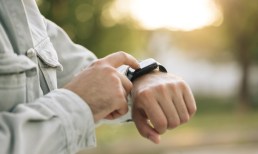Meet the 27 Million Americans Who Drive 8% of Consumer Spend but Struggle to Pay Their Bills

The big consumer news last Friday was that the University of Michigan’s June Consumer Sentiment Index hit a seven-month low. Many scratched their heads, particularly since the CPI print earlier in the week came in flat and the economy appears to be firing on all cylinders.
But there’s nothing like asking consumers how they’re feeling about their personal financial prospects — and then comparing what they say to what they do — to get the true picture. And what we see is that the other consumer spending shoe is starting to drop.
We read the stories about millionaires shopping at TJX (who probably always did), and Walmart attracting more $100,000 income shoppers (maybe some of them always did too). But you get the point — it’s now a headline because it seems more than a one-off.
At the same time, we see sales rising at recommerce sites such as The RealReal (after consecutive quarters of slowing sales) as shoppers at all income levels cast the net far and wide for deals, including those for someone else’s designer duds at a favorable price point.
According to many recent research studies by PYMNTS Intelligence, we see trade-downs in merchants and brands across all income levels as savings diminish and credit card outstandings rise.
Trading down to cheaper brands was something that PYMNTS Intelligence data showed that nearly two-thirds of consumers were already doing in January. A little more than half of consumers said they were switching to cheaper merchants then, too.
Consumers take no solace in the month-over-month decline in CPI and the flat showing in June. Regardless of income, all consumers feel caught in the struggle between persistently high prices and moderating wage growth.
As I wrote in May of this year, those declines mean nothing to the average consumer who is paying roughly 20% more at the grocery store and the gas pump now than they did in years past. CPI data shows that since inflation began in March of 2021, prices have increased by 18.4%, with retail and grocery prices increasing by 19.3% and 20.7% respectively. Alternatively, average earnings have increased by only 16.1%[1] over the same period.
That squeeze is starting to pinch retail sales.
May 2024 retail sales were released this week. The headline numbers are somewhat misleading. During the first five months of 2024, retail sales, while up by 2.3% over the first five months of 2023, are mainly up in essential items like grocery and health-related purchases and at mass merchants. However, they are all down for the year for discretionary categories such as home furnishings, building materials and hobby and leisure products.
The Lower-Income Consumer Spotlight
Recent media coverage has focused on the stress points felt by the lower-income consumer earning $50,000 a year or less. As Sezzle CEO Charlie Youakim told me a few years back, this consumer is one who lives in a constant state of recession, so the price/income crunch is their status quo. In other words, they’ve gotten pretty good over the years at figuring out how to do more with less.
But there is a bigger and potentially more meaningful story to be told — one where the usual tricks of the trade-off are becoming less effective.
One in ten U.S. consumers has an annual income of $50,000 or less, lives paycheck to paycheck and says they have issues paying their monthly bills. Not that they won’t eventually pay them, but each month becomes a game of bill-pay roulette as consumers decide which biller can wait a little longer. Interestingly, of all household bills, utilities, insurance, mobile phones and credit cards make the monthly cut — the billers that carry a big downside risk if not paid.
That makes the current price/wage/inflation dynamic hit this consumer with a potential double whammy. Not only do they struggle to make ends meet every month, but they also worry most about their wage and employment security as the labor market shows recent signs of cooling and employment alternatives may not be as plentiful.
It’s also a group of consumers whose ranks are swelling.
PYMNTS Intelligence reports a sharp spike in the number of consumers that fit this profile over the last two months — now reaching among the highest levels seen since we started tracking the paycheck-to-paycheck consumer nearly four years ago.
This is their story.
Sizing Up the Financially Stressed US Consumer
It would be easy to stereotype these 27 million consumers as poor people who don’t matter much to overall retail spend and GDP. That would be wrong.
These 27 million people represent 8% of all consumer spending. These are nurses, fire fighters, police officers, salon and spa staff, fitness instructors, teachers, the people who check you in at your hotel when you arrive, the independent truck driver who makes sure your packages arrive on time, the gig workers who deliver your groceries or take you to the airport, the people who cut your lawn and your hair, the sales associate at your favorite independent retailer, the freelance designer you hire to do your website.
In many ways, these are the consumers who help power the economic infrastructure of our cities and towns and businesses across America.
More of them have kids; fewer of them have a college degree. These consumers are not only trying to figure out how to stretch their dollars to buy what they need, but how to struggle with that and literally keep the lights on.
For people making less than $50K per year, just paying for food (25%), housing (37%) and their monthly bills (13%) now accounts for 72% of their monthly income. That’s three times more than consumers whose annual income is greater. And there isn’t much left over to buy anything that isn’t necessary to run the household.
Or save.
The savings account balances for financially stressed consumers are 75% less than the average American household, some $2600 to the nearly $11,000 for the average American. Those lower balances make it more likely that an emergency expenditure, which PYMNTS Intelligence finds is closer to $1,400 than the $400 that the Fed continues to quote, could deplete most of it.
Given their monthly income constraints, savings likely come last when the expenses of daily life get in the way. And that seems more the rule than the exception. We find that the financially stressed consumer saves half as much monthly as those living paycheck to paycheck and comfortably paying their bills — so rebuilding those savings can take a lot longer.
The lack of a cash cushion means that these consumers are always living on a knife’s edge. In the event of any financial emergency, they often lack access to credit, so are 30% more likely to be forced to sell assets or turn to family, friends or predatory lenders than the average consumer.
Cash on Hand Rules
Unsurprisingly, financially stressed consumers use debit or cash to make most of their purchases — 27% more often than the average consumer — and more out of necessity than choice. These consumers are also highly leveraged, and their credit options are more limited.
PYMNTS Intelligence data finds that their credit cards are often declined at the point of sale — nearly one in every five times — for not having enough available credit to make the purchase. More than twice as many financially stressed consumers either struggle to pay the monthly minimum or pay nothing, as compared to the average consumer.
That makes purchases using cards more expensive and the ability to pay off their balances a challenge. As a cohort, 76% of financially stressed consumers revolve their monthly balances, compared to 48% of the average credit cardholder in the U.S.
Physical Stores Get Their Business
Most financially stressed consumers choose to shop in a store rather than order online. They are willing to trade off the value of their time for the chance to examine products, compare prices and pay with cash on hand (debit or cash) at checkout.
Cash, as a payment tender, is used by this cohort 53% more often than the average consumer, and 2.3 times more frequently than high earners. For financially stressed consumers, it is also their best budgeting tool. It’s pretty straightforward to decide how and when and how much to spend money when the stack of bills in their leather wallets is a visible reminder of how much they have left to spend.
Financially stressed consumers are also much more likely to shop at Walmart, naming Walmart 28% of the time when asked the name of the merchant from which they made their most recent purchase; 27% more often than the average consumer.
Financially Stressed but Highly Connected
Across all income segments, consumers who say they are living paycheck to paycheck with issues paying their bills are more digitally engaged than those who are not.
It may be that these consumers rely more on their mobile devices and apps to find deals, compare prices, check their balances and scan sites for coupons to redeem at checkout to save money.
And to receive payments and do their banking. In fact, these struggling consumers use neobanks as their primary bank accounts more frequently than others. Currently, 14.5% of this struggling cohort say they use neobanks such as PayPal, Venmo, Chime, Ally and Cash App as their primary bank account. This is slightly higher than the 13.2% rate for the average American adult.
They use these non-bank wallets to send and receive money. PYMNTS Intelligence data shows the majority of service workers that receive tips paid directly by consumers receive these tips in cash. However, 23% also receive some of these tip payments using digital apps such as Venmo, PayPal or Cash App accounts.
The Paycheck-to-Paycheck Consumer
Financially stressed consumers aren’t the only ones who live paycheck to paycheck in the U.S.
The PYMNTS Intelligence team has been tracking the behaviors of the paycheck-to-paycheck consumer since March of 2020. We’ve done that by breaking consumers into three distinct cohorts based on how consumers describe the struggles of their financial lifestyle: Those who live paycheck to paycheck with issues paying bills; those without issues paying bills but who need their next paycheck to manage their household bills; and those who say they do not live paycheck to paycheck.
Today, 65% of the U.S. population lives paycheck to paycheck, the highest share we have seen in two years.
Eighty percent of consumers earning less than $50,000 annually say they live paycheck to paycheck. More than two thirds (68%) of those in the middle-income range, those earning between $50,000 and $75,000, and 49% of those earning over $100,000 say they do, too. In fact, even 34% of those making over $200K per year also live paycheck to paycheck.
In May 2024, we also find that slightly more than one in five U.S. consumers (21.2%) report living paycheck to paycheck with issues paying their bills.
The 27 million financially stressed consumers you’ve just read about represent nearly half (48%) of this paycheck-to-paycheck cohort that also earns $50,000 a year or less. Twenty-one percent of them are Gen Z.
These 27 million consumers would love nothing more than to reduce the daily stress that comes from worrying about making ends meet. Innovators and their investors would love nothing more than to find an addressable market where new technologies and data can deliver a compelling product for a willing buyer who can become a loyal customer.
Perhaps this financially stressed consumer — most often overlooked — is a compelling opportunity to improve the shopping, payment and savings experience using apps and the mobile phone. The chance to optimize these finance essentials might be a payments and commerce blue ocean.
Yes, but it’s a tricky group to serve. They are price- and fee-sensitive. To be successful, products and business models must consider levers other than interchange fees to drive scale and profits.
We see FinTech banking, shopping and payments apps stepping in to fill the void with new product offers and bundled products and capabilities that create better economics for themselves and the financially stressed consumer they serve. Embedding products into platforms with a critical mass of these consumers can reduce customer acquisition costs, provided the value proposition is aligned, as they build their own. Innovators are blending payments and savings capabilities into a single product for financially stressed consumers. Pay in 3 or 4 provides short term, small dollar credit to help consumers manage their monthly budget, build credit and buy what is needed for themselves and their families.
For these consumers, innovations in how they spend, shop, pay and save aren’t just a nice-to-have. And they can’t come soon enough.
[1] Bureau of Labor Statistics, Current Employment Statistics Survey.



